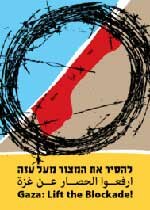By Amira Hass, Haaretz – 20 June 2011
www.haaretz.com/print-edition/features/palestinian-economic-boom-unsustainable-without-overseas-donations-1.368629
If the Palestinian economy is growing, then why are unemployment figures up?

Amira Hass
How nice it would be if statistics and events on the ground would line up in a logical, orderly manner, without any inconsistencies. How easy it would be to report then.
The following event was reported on Saturday by the Palestinian news agency Ma’an: Homeless residents of the southern Gaza Strip blocked access to UNRWA (United Nations Relief and Works Agency for Palestinian Refugees in the Near East ) summer camps to protest the fact that the organization has not yet rebuilt their homes, which Israel destroyed during the second intifada. According to the demonstrators, 40,000 refugee families have lost their homes since 2000, but UNRWA has preferred to give priority to rebuilding homes destroyed by Israel in Operation Cast Lead.
Even if the figures are not precise, it underscores the distress and insult felt by those who inhabited those houses destroyed in 2001, then in 2003 and in 2004 in the refugee camps of Khan Yunis and Rafah. In order to protect the fortified and spacious settlements surrounded by greenery that were just 20 meters away, Israeli army bulldozers razed those crowded rows of gray houses, with asbestos roofs surrounded by sand. Guided by the logic of generals and Caterpillar commanders, the houses were taken down one by one.
Following delays that cost many lives, the settlements were eventually evacuated. Their residents were generously compensated. But the residents of the camps, refugees from Yibne and Burayr, Isdud and Beit Tima, continue to wander from one temporary apartment to another. They are waiting for UNRWA to compensate them for the homes that Israel destroyed. They are demonstrating against UNRWA, even though the real address for their complaints should the Knesset in Jerusalem and the Defense Ministry compound in Tel Aviv. But of course, they cannot obtain entry permits into Israel.
And here comes the surprising statistic: The June issue of the Ramallah-based Palestinian Economic Bulletin, published by The Palestine Economic Policy Research Institute MAS (with headquarters in Ramallah ), reports that unemployment in the Gaza Strip plummeted from 37.4 percent in the last quarter of 2010 to 30.8 percent in the first quarter of 2011 (with most of the added jobs in agriculture ). In the West Bank, on the other hand, unemployment rose slightly from 16.9 percent in the last quarter of 2010 to 17.4 percent in the first quarter of this year.
It is too early to say whether these quarterly changes indicate a trend that should be cause for concern. But a report by UNRWA, which analyzed developments in the West Bank job market in the second half of 2010, did find that unemployment is on an upward trend. Just to make things more confusing, the UNRWA report also includes in its labor force figures those unemployed who have given up looking for work. That explains why according to its figures,, in the first half of 2010, the unemployment rate on the West Bank was a much higher 25 percent – up from 21.7 percent In the first half of 2010 and 23.6 percent in the second half of 2009. The UNRWA figures seem to signal deceleration of economic growth.
The economic reports published by UNRWA are designed to gauge employment trends among Palestinian refugees so that the agency can adapt its policies and projects accordingly. The latest report, published last week, found that in the second half of 2010, the size of the West Bank refugee labor force declined, as compared with the second half of 2009. The refugee labor force participation rate dropped from 43.7 percent (among total working age refugees ) to 40 percent. The total Palestinian labor force participate rate (refugees and non-refugees ) is higher, comprising 47 percent of the total working age population.
It could be an error in calculation (which becomes likelier the smaller the sampling ), says Dr. Salem Ajluni, the author of the study. And perhaps more refugees of working age are studying or taking care of an elderly parent at home. UNRWA will need to continue to study the matter.
What is clear is that unemployment among Palestinian refugees has increased. After dropping from 26.7 percent at the end of 2009 to 25.5 percent in the first half of 2010, it went up to 27.9 percent in the second half of 2010. Wages in this group are also relatively low. According to the UNRWA figures, at the end of 2009, the real average monthly salary among Palestinian refugees in the West Bank was NIS 1,665, compared with NIS 1,815 among non-refugees. At the end of 2010, the real average monthly salary among refugees was NIS 1,614, compared with NIS 1,795 among non-refugees.
Ajluni, who was born in the United States and is the scion of a Palestinian family from Ramallah, has been studying the economy of the occupied Palestinian territories for the past 20 years. He has worked in various UN agencies and Palestinian Authority ministries. Since 2006, he has been employed by UNRWA. “I went to look for the flourishing West Bank economy, which everyone is talking about,” he said yesterday. He does not have to look far: The MAS economic bulletin reported a 9.3 percent increase in Palestinian GDP in 2010, and a per capita increase of 6.1 percent.
But Ajluni also sees what is happening in the job market. “True, there are investments, but most of them are in construction,” he says. “These are not investments that create long-term jobs. Although I’ve seen an increase in jobs, there is a greater increase in the number of unemployed. The absolute number of people who have found work is about a quarter of those who looked for work. It’s true that there is commercial activity and about 90,000 jobs in commerce and in the public sector on the West Bank and a similar number in the Gaza Strip whose salaries create buying power.”
Still, whenever donations from abroad are delayed, he notes, so are salary payments. “Without annual external assistance to the tune of about $1 billion from the donor countries, this is not a sustainable situation. I’m not the only one saying this. So is the World Bank, the International Monetary Fund and [Palestinian Prime Minister] Salam Fayyad.”






































